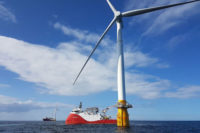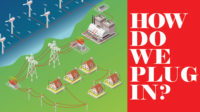Clean Energy Construction
US Offshore Wind Energy Makes First Official West Coast Push

U.S. offshore wind energy has officially gone bi-coastal, with the U.S. Interior Dept. set to auction on Dec. 6 five ocean areas totaling 373,268 acres off northern and central California that it says could produce more than 4.5 GW of clean power and would be America's first development on the Outer Continental Shelf using floating wind turbines.
Developer interest is high with 43 bidders qualified to vie for five leases, located in three deep-water areas off Morro Bay in central California and in two areas off Humboldt Bay in the northern part of the state, located about 20 miles offshore, said the department in announcing its final auction notice on Oct. 18.
"California is the second most-energy-using state, the fifth largest economy in the world and a renewable energy pioneer, setting a goal of transitioning to 100% clean retail electricity by 2045," says the U.S. Energy Dept.'s National Renewable Energy Laboratory (NREL).
In a key change, the Interior notice says that bidders can win only one lease, Jim Lanard, CEO of floating wind developer and potential bidder Magellan Wind, told ENR. It is set to be published in the Federal Register by Oct. 21.
In its bid, Magellan has teamed with Copenhagen Infrastructure Partners, developer of Vineyard Wind, the 2.8-GW Massachusetts project that now is under construction as a fixed-bottom multi-turbine project that will be the country's first utility-scale offshore wind development.
Eligible west coast bidders also include Castle Wind, a joint venture of floating offshore wind pioneer Trident Wind and Europe-based multi-energy developer TotalEnergies. Other large auction qualifiers include units of global energy companies Orsted, Equinor, Avangrid, Shell New Energies, EDF, RWE, Marubeni Power and Ferrovial Energy.

Floating offshore wind turbines require unique mooring systems to hold them in place, which can increase the space needed for wind power plant development. Classic floating platform concepts can include spar (left), semisubmersible (center), and tension leg platforms (right)
Credit: Joshua Bauer-US National Renewable Energy Laboratory
Environmental Review: 'No Significant Impact'
The department's Bureau of Ocean Energy Management earlier this month said its environmental review of the Morro Bay offshore wind development area found that "responsible commercial development will have no significant impacts." A similar assessment of the Humboldt Bay area was released in May. Further reviews will be done when winning bidders submit a project construction and operations plan, BOEM said.
"We know more than half the nation’s offshore wind resources are in deep waters and floating wind is going to help reach those areas that were thought unobtainable, said BOEM Director Amanda Lefton, in announcing the lease auction at an industry conference in Providence, R.I.
Several lease stipulations are designed to promote domestic supply chain development, advance flexibility in transmission planning and boost job creation, the agency said.
BOEM will require winning bidders to “make every reasonable effort” to enter into project labor agreements. It will also offer bidding credits for those that enter "community benefits" agreements and invest in workforce training or supply chain development. Bidders also must engage with tribes, underserved communities, ocean users and agencies, it said.
“This is very important as communities will feel the benefits, and possible impacts, of offshore wind projects," Alla Weinstein, Castle Winds CEO and founding CEO of Trident Winds, told ENR. She has been involved in west coast offshore wind energy development since 2016, when Castle Winds submitted the first unsolicited lease request to state and federal agencies to develop a Morro Bay area project.and signed an agreement with the city of Morro Bay.
Castle Winds said Oct. 19 it has formed a new mutual benefits corporation with two Morro Bay area commercial fishing groups for the industry to demonstrate to the state's fishing industry, the Interior Dept. and the California Coastal Commission "the commitment of project developers to responsible offshore wind development that protects and supports a sustainable commercial fishing industry." The company says the corporation is open to other area developers and eligible individuals in commercial fishing.
Weinstein said the value of federal credits "should have been higher for the community benefits agreements.”
Floating offshore wind energy development is set for more U.S. growth. In mid-September, the White House launched a program to accelerate breakthroughs across engineering, manufacturing and other areas to reduce the cost of its energy production by more than 75%, to $45/MWh by 2035. The administration also set a goal for 15 GW of floating offshore wind capacity installed by 2035, in addition to the existing goal to deploy by 2030, 30 GW of offshore wind primarily using fixed-bottom technology.
Updated Project Standards Now Out
In another key offshore wind energy market step, NREL announced on Oct. 14 the first of five guidance documents that will set new broadened standards for offshore wind energy project development—including design, manufacturing, fabrication, transportation, installation, operation, in-service inspection and decommissioning. Developed by a 100-member group of government and private industry experts, it was approved recently by the American National Standards Institute (ANSI) and replaces decade-old guidance.
“These recommended practices cover a broader scope than anything previously available to the offshore wind energy industry,” said Walt Musial, a mechanical engineer who leads NREL offshore wind research and heads the expert group. "Regulators hold responsibility for all stages of development—from cradle to grave—and we’ve now provided them more comprehensive guidance in one document. ” He says it could lead to speedier regulatory approvals and increased worker safety.
Other standards set to be approved by ANSI this year address requirements for floating wind technology, submarine cables, meteorological and oceanographic data and geotechnical and geophysical standards.
Coastal states increased long-term offshore wind targets by 58% to 77.4 GW in the third quarter of 2022, setting a record for quarterly growth, says sector advocacy group Business Network for Offshore Wind, which cites a federal funding boost from the Inflation Reduction Act’s $369 billion in clean energy spending and tax credits and increased deployment goals in California and New Jersey.
“The U.S. offshore wind industry should see this as a huge opportunity," Tony Appleton, offshore wind director at Burns & McDonnell told ENR. "If we can train the resources and develop out the supply chain, the U.S. can become a net exporter in global offshore wind,”





